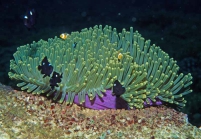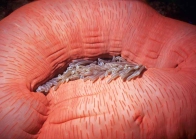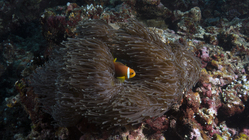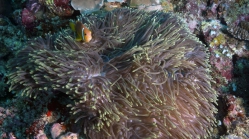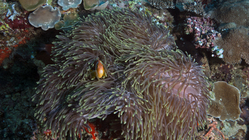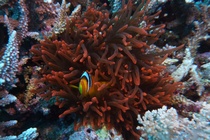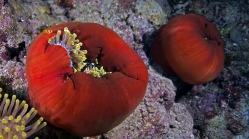
URMO name detailsHeteractis magnifica (Quoy & Gaimard, 1833)
290090 (urn:lsid:marinespecies.org:taxname:290090)
unaccepted
Species
Radianthus mabrucki (Carlgren, 1900) · unaccepted
Radianthus ritteri (Kwietniewski, 1897) · unaccepted (also syn of Heteractis crispa)
marine,
(of ) Quoy, J. R. C.; Gaimard, J. P. (1833). Zoologie IV: Zoophytes. In:Zoologie. Voyage de la corvette l'Astrolabe : ex�cut� par ordre du roi, pendant les ann�es 1826-1827-1828-1829 / sous le commandement de J. Dumont d'Urville. pp. 1-390. Paris, J. Tastu., available online at https://www.biodiversitylibrary.org/page/2064339
page(s): 140-141 [details]
Rodr?guez, E.; Fautin, D; Daly, M. (2024). World List of Actiniaria. Heteractis magnifica (Quoy & Gaimard, 1833). Accessed through: Land J. van der (ed). (2008) UNESCO-IOC Register of Marine Organisms (URMO) at: https://www.marinespecies.org/urmo/aphia.php?p=taxdetails&id=290090 on 2024-04-23
Land J. van der (ed). (2008). UNESCO-IOC Register of Marine Organisms (URMO). Heteractis magnifica (Quoy & Gaimard, 1833). Accessed at: https://www.marinespecies.org/urmo/aphia.php?p=taxdetails&id=290090 on 2024-04-23
Date action by
original description
(of ) Quoy, J. R. C.; Gaimard, J. P. (1833). Zoologie IV: Zoophytes. In:Zoologie. Voyage de la corvette l'Astrolabe : ex�cut� par ordre du roi, pendant les ann�es 1826-1827-1828-1829 / sous le commandement de J. Dumont d'Urville. pp. 1-390. Paris, J. Tastu., available online at https://www.biodiversitylibrary.org/page/2064339
page(s): 140-141 [details] context source (Hexacorallia) Fautin, Daphne G. (2013). Hexacorallians of the World. (look up in IMIS) [details] basis of record den Hartog, J. C. & van der Land, J. (2000-2007). As a contribution to UNESCO-IOC Register of Marine Organisms. (look up in IMIS) [details] additional source Fautin, Daphne G. (2013). Hexacorallians of the World. (look up in IMIS) [details] additional source Dunn, D. F. (1981). The clownfish sea anemones: Stichodactylidae (Coelenterata: Actiniaria) and other sea anemones symbiotic with pomacentrid fishes. Transactions of the American Philosophical Society, 71, 1, 1-115 page(s): 3-6, 27, 39-48, 103-106-108 [details] additional source Fautin, D. G. (1988). Sea anemones (Actiniaria and Corallimorpharia) of Madang Province. Science in New Guinea, 14(1): 22-29 page(s): 23 Tab. 1, 26 [details] additional source Fautin, D. G.; Bucklin, A. (1988). Anthozoan dominated benthic environments. volume 3, pp. 231-236 page(s): 233 [details] additional source Fautin, D. G. (1985). Competition by anemone fishes for host actinians. Proceedings of the Fifth International Coral Reef Congress, 5, 373-377 page(s): 373-377 [details] additional source Fautin, D. G. (1986). Why do anemonefishes inhabit only some host actinians?. Environmental Biology of Fishes, 15(3): 171-180 page(s): 172-173 [details] additional source Arvedlund, M.; McCormick, M. I.; Fautin, D. G.; Bilds�e, M. (1999). Host recognition and possible imprinting in the anemonefish Amphiprion melanopus. Marine Ecology Progress Series, 188, 207-218 page(s): 208, 213-216 [details] additional source Arvedlund, M.; Bundgaard, I.; Nielsen, L. E. (2000). Host imprinting in anemonefishes (Pisces: Pomacentridae): does it dictate spawning site preferences?. Environmental Biology of Fishes, 58, 203-213 page(s): 203, 206-208 [details] additional source den Hartog, J. C. (1997). The sea anemone fauna of Indonesian coral reefs. Periplus Editions. Republic of Singapore., chapter Box 8.2, volume 7, pp. 351-370 page(s): 353 [details] additional source Paulay, G.; Puglisi, M. P.; Starmer, J. A. (2003). The non-scleractinian Anthozoa (Cnidaria) of the Mariana Islands. Micronesica, 35-36, 138-155 page(s): 148 [details] additional source Mitchell, J. S. (2003). Mobility of Stichodactyla gigantea sea anemones and implications for resident false clown anemonefish, Amphiprion ocellaris. Environmental Biology of Fishes, 66, 85-90 page(s): 87 [details] additional source Fautin, D. G. (1992). Anemonefish recruitment: the roles of order and chance. Symbiosis, 14, 143-160 page(s): 144, 145, 146, 146, 146, 148, 149, 154, 155, 156, 158 [details] additional source Honma, T.; Nagai, H.; Nagashima, Y.; Shiomi, K. (2003). Molecular cloning of an epidermal growth factor-like toxin and two sodium channel toxins from the sea anemone Stichodactyla gigantea. Biochimica et Biophysica Acta, 1652, 103-106 page(s): 105 Fig. 2 [details] additional source Tu, H.; Xiong, Q.; Zhen, S.; Zhong, X.; Peng, L.; Chen, H.; Jiang, X.; Liu, W.; Yang, W.; Wei, J.; Dong, M.; Wu, W.; Xu, A. (2003). A naturally enhanced green fluorescent protein from magnificent sea anemone (Heteractis magnifica) and its functional analysis. Biochemical and Biophysical Research Communications, 301, 879-885 page(s): 879-883, Figure 1 [details] additional source Maragos, J. E.; Kenyon, J. (2004). Rose Atoll coral data compiled from US Fish and Wildlife Service 1994, Townsend Cromwell 2002, and Sette 2004 surveys [Table 10]. UNPUBLISHED, Unpublished page(s): 1 [details] additional source Maragos, J. E. (2004). Baker Island coral data [Table unnumbered]. UNPUBLISHED, Unpublished page(s): 2 [details] additional source Astalhov, D. A. (2002). Species composition of anemonefishes (Perciformes, Pomacentridae) and their host sea anemones (Cnidaria, Actiniaria) in the Khanhhoa Province (South Vietnam). Journal of Ichthyology, 42(1): 37-50 page(s): 37-38, 41-43, 46-49 [details] additional source Brolund, T. M.; Tychsen, A.; Nielsen, L. E.; Arvedlund, M. (2004). An assemblage of the host anemone Heteractis magnifica in the northern Red Sea, and distribution of the resident anemonefish. Journal of the Marine Biological Association of the United Kingdom, 84, 671-674 page(s): 671-672, 674 [details] additional source Stoletzki, N.; Schierwater, B. (2005). Genetic and color morph differentiation in the Caribbean sea anemone Condylactis gigantea. Marine Biology, 147, 747-754 page(s): 749 [details] additional source Hattori, A. (2006). Vertical and horizontal distribution patterns of the giant sea anemone Heteractis crispa with symbiotic anemonefish on a fringing coral reef. Journal of Ethology, 24(1): 51-57 page(s): 55 [details] additional source Ilyna, A. P.; Monastyrnaya, M. M.; Sokotun, I. N.; Egorov, T. A.; Nazarenko, Y. A.; Likhatskaya, G. N.; Kozlovskaya, E. P. (2005). Actinoporins from the Sea of Japan anemone Oulactis orientalis: isolation and partial characterization. Russian Journal of Bioorganic Chemistry, 31(1): 34-42 page(s): 38, 40 [details] additional source Holbrook, S. J.; Schmitt, R. J. (2005). Growth, reproduction and survival of a tropical sea anemone (Actiniaria): benefits of hosting anemonefish. Coral Reefs, 24(90): 67-73 page(s): 67, 68, 70, 71, 72, 73 [details] additional source Klyshko, E. V.; Issaeva, M. P.; Monastyrnaya, M. M.; Ilyna, A. P.; Guzev, K. V.; Vakorina, T. I.; Dmitrenok, P. S.; Zykova, T. A.; Kozlovskaya, E. P. (2004). Isolation, properties and partial amino acid sequence of a new actinoporin from the sea anemone Radianthus macrodactylus. Toxicon, 44, 315-324 page(s): 315-316, 320-322 [details] additional source Mitchell, J. S.; Dill, L. M. (2005). Why is group size correlated with the size of the host sea anemone in the false clown anemonefish?. Canadian Journal of Zoology, 83, 372-376 page(s): 375 [details] additional source Il'ina, A. P.; Monastyrnaya, M. M.; Isaeva, M. P.; Guzev, K. V.; Rasskazov, V. A.; Kozlovskaya, E. P. (2005). Primary structures of actinoporins from sea anemone Oulactis orientalis. Russian Journal of Bioorganic Chemistry, 31(4): 320-324 page(s): 320-322 [details] additional source Fautin, D. G. (1991). The anemonefish symbiosis: what is known and what is not. Symbiosis, 10, 23-46 page(s): 26 [details] additional source Acu�a, F. H.; Griffiths, C. L. (2004). Species richness, endemicity and distribution patterns of South African sea anemones (Cnidaria: Actiniaria & Corallimorpharia). African Zoology, 39(2): 193-200 page(s): 196 [details] additional source Arvedlund, M.; Hattori, A.; Iwao, K.; Takemura, A. (2006). When cleanerfish become anemonefish. Journal of the Marine Biological Association of the United Kingdom, 86, 1265-1266 page(s): 1265, 1266 [details] additional source Zamponi, M. O. (2005). Estudio de la reproducci�n sexual de las an�monas de mar (Actiniaria) y la estrategia del hombre pobre (the poor man's game). Revista Real Academia Galega de Ciencias, 24 page(s): 7 [details] additional source Scott, A.; Harrison, P. L. (2007). Broadcast spawning of two species of sea anemone, Entacmaea quadricolor and Heteractis crispa, that host anemonefish. Invertebrate Reproduction and Development, 50(3): 163-171 page(s): 168 [details] additional source Buston, P. M.; Cant, M. A. (2006). A new perspective on size hierarchies in nature: patterns, causes, and consequences. Oecologia, 149, 362-372 page(s): 362, 363 [details] additional source Chadwick, N. E.; Arvedlund, M. (2005). Abundance of giant sea anemones and patterns of association with anemonefish in the northern Red Sea. Journal of the Marine Biological Association of the United Kingdom, 85(5): 1287-1292 page(s): 1287, 1288 [details] additional source Kokshoorn, B.; Goud, J.; Gittenberger, E. (2007). Epitoniid parasites (Gastropoda, Caenogastropoda, Epitoniidae) and their host sea anemones (Cnidaria, Actiniaria, Ceriantharia) in the Spermonde archipelago, Sulawesi, Indonesia. Basteria, 71, 33-56 page(s): 48, 52 [details] additional source Arvedlund, M.; Iwao, K.; Brolund, T. M.; Takemura, A. (2006). Juvenile Thalassoma amblycephalum Bleeker (Labridae, Teleostei) dwelling among the tentacles of sea anemones: a cleanerfish with an unusual talent?. Journal of Experimental Marine Biology and Ecology, 329, 161-173 page(s): 161, 164, 165, 166, 167, 168, 169, 170, 171 [details] additional source Daly, M.; Chaudhuri, A.; Gusm�o, L.; Rodr�guez, E. (2008). Phylogenetic relationships among sea anemones (Cnidaria: Anthozoa: Actiniaria). Molecular Phylogenetics and Evolution, 48, 292-301 page(s): 295, 297, 298 [details] additional source Hasegawa, Y.; Honma, T.; Nagai, H.; Ishida, M.; Nagashima, Y.; Shiomi, K. (2006). Isolation and cDNA cloning of a potassium channel peptide toxin from the sea anemone Anemonia erythraea. Toxicon, 48, 536-542 page(s): 536, 537, 540 [details] additional source Fautin, D. G.; Tan, S. H.; Tan, R. (2009). Sea anemones (Cnidaria: Actiniaria) of Singapore: abundant and well-known shallow-water species. Raffles Bulletin of Zoology, 22, 121-143 page(s): 121, 123, 135-136, 139, 140 [details] additional source den Hartog, J. C. (1994). Sea anemones of the Seychelles. J. van der Land (eds.). National Museum of Natural History. Leiden, chapter 6.2, volume 2, pp. 75-79 page(s): 77, 78 [details] additional source Daly, M.; Gusm�o, L.; Reft, A. J.; Rodr�guez, E. (2010). Phylogenetic signal in mitochondrial and nuclear markers in sea anemones (Cnidaria, Actiniaria). Integrative and Comparative Biology, 50(3): 371-388 page(s): 374, 375 [details] additional source Honma, T.; Minagawa, S.; Nagai, H.; Ishida, M.; Nagashima, Y.; Shiomi, K. (2005). Novel peptide toxins from acrorhagi, aggressive organs of the sea anemone Actinia equina. Toxicon, 46, 7, 768-774 page(s): 773 [details] additional source Alegre-Cebollada, J.; O�aderra, M.; Gavilanes, J. G.; Mart�nez del Pozo, A. (2007). Sea anemone actinoporins: the transition from a folded soluble state to a functionally active membrane-bound oligomeric pore. Current Protein and Peptide Science, 8, 558-572 page(s): 559 [details] additional source Hoeksema, B. W.; Crowther, A. L. (2011). Masquerade, mimicry and crypsis of the polymorphic sea anemone Phyllodiscus semoni and its aggreagations in South Sulawesi. Contributions to Zoology, 80(4): 251-268 page(s): 259 [details] additional source Allen, G. R.; Drew, J.; Fenner, D. P. (2011). Amphiprion pacificus, a new species of anemonefish (Pomacentridae) from Fiji, Tonga, Samoa, and Wallis Island. Aqua -- International Journal of Ichthyology, 16(3): 129-138 page(s): 137 [details] additional source Dunn, D. F. (1985). Sea anemones that harbor symbiotic pomacentrid fishes in the western Pacific. National Geographic Society Research Reports, 18, 279-283 page(s): 280 [details] additional source den Hartog, J. C. (1997). Notes on the genus Amphiprion Bloch & Schneider, 1801 (Teleostei: Pomacentridae) and its host sea anemones in the Seychelles. Zoologische Mededelingen, Leiden, 71(17), 181-188 page(s): 182-184, 186, 188 [details] additional source Hirose, Y. (1985). Habitat, distribution and abundance of coral reef sea-anemones (Actiniidae and Stichodactylidae) in Sesoko Island, Okinawa, with notes on expansion and contraction behavior. Galaxea, 4(2), 113-127 page(s): 114, 116, 118 [details] additional source Il'ina, A. P.; Lipkin, A.; Barsova, E.; Issaeva, M. P.; Leychenko, E.; Guzev, K. V.; Monastyrnaya, M. M.; Lukyanov, S.; Kozlovskaya, E. P. (2006). Amino acid sequence of RTX-A's isoform actinoporin from the sea anemone, Radianthus macrodactylus. Toxicon, 47, 517-520 page(s): 517, 518 [details] additional source Honma, T.; Kawahata, S.; Ishida, M.; Nagai, H.; Nagashima, Y.; Shiomi, K. (2008). Novel peptide proteins from the sea anemone Stichodactyla haddoni. Peptides, 29, 536-544 page(s): 543 [details] ecology source Bennett-Smith, M. F.; Majoris, J. E.; Titus, B. M.; Berumen, M. L. (2021). Clownfish hosting anemones (Anthozoa, Actiniaria) of the Red Sea: new associations and distributions, historical misidentifications, and morphological variability. <em>Marine Biodiversity Records.</em> 14(1)., available online at https://doi.org/10.1186/s41200-021-00216-6 [details]  Present Present  Inaccurate Inaccurate  Introduced: alien Introduced: alien  Containing type locality Containing type locality
To Barcode of Life (59 barcodes)
To Biodiversity Heritage Library (1 publication) To Biodiversity Heritage Library (2 publications) (from synonym Radianthus ritteri (Kwietniewski, 1897)) To Biodiversity Heritage Library (2 publications) (from synonym Radianthus mabrucki (Carlgren, 1900)) To Biological Information System for Marine Life (BISMaL) (from synonym Radianthus ritteri (Kwietniewski, 1897)) To Digital Atlas Of Marine Species & Locations, DAMSL (Magnificent Sea Anemone) To Digital Atlas Of Marine Species & Locations, DAMSL (Magnificent Sea Anemone) To Digital Atlas Of Marine Species & Locations, DAMSL (Magnificent Sea Anemone) To Digital Atlas Of Marine Species & Locations, DAMSL (Magnificent Sea Anemone) To Digital Atlas Of Marine Species & Locations, DAMSL (Magnificent Sea Anemone) To Digital Atlas Of Marine Species & Locations, DAMSL (Magnificent Sea Anemone) To European Nucleotide Archive (ENA) To GenBank (224 nucleotides; 132 proteins) To GenBank (224 nucleotides; 132 proteins) (from synonym Radianthus ritteri (Kwietniewski, 1897)) To Global Biotic Interactions (GloBI) To USNM Invertebrate Zoology Cnidaria Collection (15 records) To ITIS |
